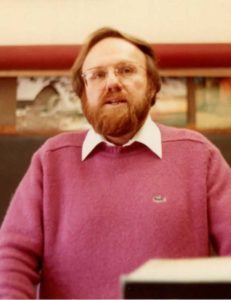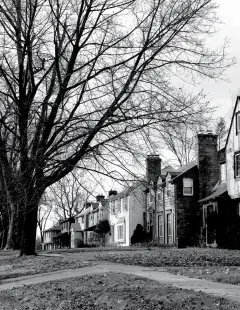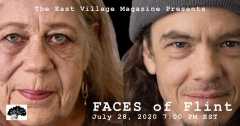By Tim Retzloff
Ray Bearden’s long career as a teacher at Flint Central High School left an indelible imprint on thousands of students whose lives he transformed. Mr. James “Ray” Bearden died in August at age 84. His obituary circulated on Facebook but, sadly, his passing did not receive mention in the Flint Journal or on MLive.
I was privileged to have Mr. Bearden more than four decades ago for 12th grade humanities. This capstone course of the Flint Community Schools’ Magnet Program took a deep dive into Truth, Beauty, Love, Justice, and Faith in a year-long two-hour block, Monday through Friday. The class was sweeping and ambitious.
Mr. Bearden started with the Big Bang and hurled forward through the coalescing of galaxies and the solar system and the formation of the earth some four-and-a-half billion years ago, and on to shifting continents, ice ages, emerging life forms, and the evolution of homo habilis with Stone Age tools, homo erectus with super orbital ridges and able to walk upright, and homo sapiens notable for large brains and mating face-to-face.

Ray Bearden, 1982. (Photo submitted by Tim Retzloff)
He taught us about the domestication of agriculture in the Fertile Crescent of ancient Mesopotamia, the Epic of Gilgamesh, and Hammurabi’s Code. We learned about Egyptian pharaohs, pyramid building, and the process of mummifying the dead that included yanking brains out of nostrils. Then onward to lectures on Athens and Sparta, the Peloponnesian Wars, Alexander the Great, and the reach of the Roman Empire. We covered Constantine and Charlemagne, the Crusades, and lineages of European monarchs in week after week of historical footraces, fingers racing to jot down notes as fast as we could.
In addition to history, the course was immersed with a thread of western philosophy from Plato’s “Allegory of the Den” to René Descartes (“I think therefore I am”) to the Existentialists, settling into a tentative definition of Truth as “agreement on the validity of experience.”
We explored early Egyptian, Greek, and Roman religions with their pantheons of gods. We followed the shift from polytheism to monotheism with the rise of Zoroastrianism and its influence on the Abrahamic faiths of Judaism, Christianity, and Islam. Mr. Bearden had us parse the Yahwistic, Elohistic, Deuteronomistic, and Priestly authorship of Hebrew scripture. Heady stuff for high school seniors.
We also had heavy doses of art and architecture, reading Tolstoy’s “What Is Art?” and learning about domes and arches, about Doric, Ionic, and Corinthian columns. Mr. Bearden played us, and tested us on, Beethoven’s symphonies. He had us listen to Mozart and invited us to bring in our own music to share. Anne offered up a song by Simon and Garfunkel, Wally offered up the Police, Carol offered up ABBA, Karri offered up Deep Purple.
Early on he assigned us to write an essay on parochialism to prod us beyond our limited personal perspectives. Other assignments included retelling Chekhov’s short story “The Bet” from the lawyer’s vantage point and doing a paper that interrogated some microcosm. I remember writing about John Steinbeck’s Of Mice and Men as a “microcosm of lonliness” and got an A- for misspelling “loneliness.” We had the option to re-write papers for a higher grade, so I resubmitted a corrected version only to still get an A-.
For a major art project, I created a collage of friends, classmates, and teachers drawing cartoon bodies on photocopied heads. I portrayed Mr. Bearden finger pointed up at his lectern with a sign taped in front with the Socrates catchphrase “All that I know is that I know nothing.” The collage hung on this bulletin board by the door for part of a semester.
He rounded out each year with a Meeting of the Minds, modeled after Steve Allen’s PBS show, with students researching key figures in history and adopting their personas, a kind of cosplay for brainy kids. When I proposed coming as Vincent Van Gogh, he asked if I planned to cut off my ear.
The course attracted the top students in the Flint schools, many (perhaps most) the daughters and sons of attorneys, doctors, professors, and engineers. My classmates included Anne Kugler, John Vaughan, John Corser, Steve Segar, Barry McDougall, Vivienne Outlaw, Prentice Zinn, Jim Beaubien, Margaret Badar, Janet Morse, Walter Soon, Kris Nieuwenhuis, Kristine Golubovskis, Rick Thompson, Tracy Edwards, Carol Rice, Sally Lam, and Steve Graham. Those that I have kept in touch with went on to earn advanced degrees, pursuing careers in academia, education, theater, cinema, the law, the clergy, and public service.
Not everyone in Mr. Bearden’s humanities class came from the proverbial middle class. Some, like me, came from less privileged backgrounds where college was hardly a given, maybe even a pipe dream. For us, his influences was especially pronounced, opening new worlds of knowledge, and the opportunities that knowledge can provide.
Mr. Bearden set an example for living a thoughtful, engaged life. In doing so, he exemplified the best of the Flint Community Schools and the best of public education: demanding and exhilarating and mind-blowing. His profound impact shaped me, shaped friends that remain my closest to this day, shaped my Central and Northern classmates from the class of 1982, and shaped generations of students fortunate to experience his teaching.
Flint native Tim Retzloff teaches history and LGBTQ studies at Michigan State University.



You must be logged in to post a comment.